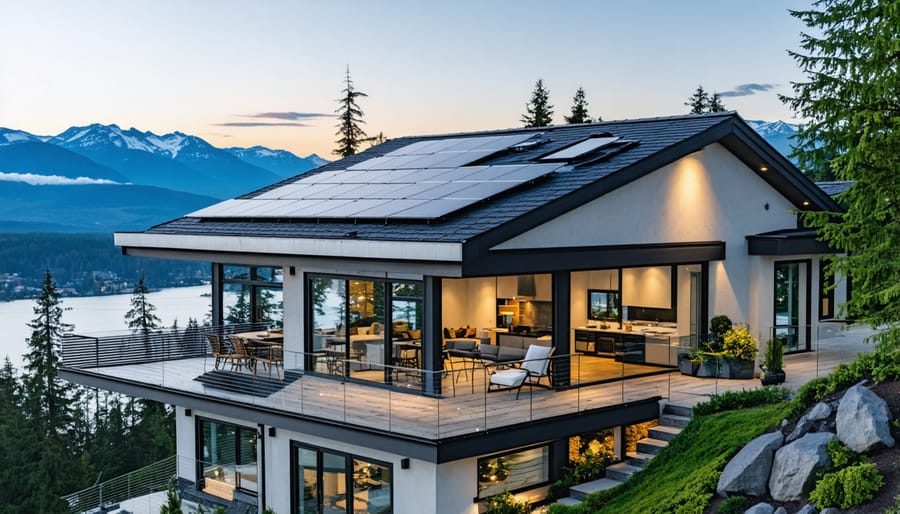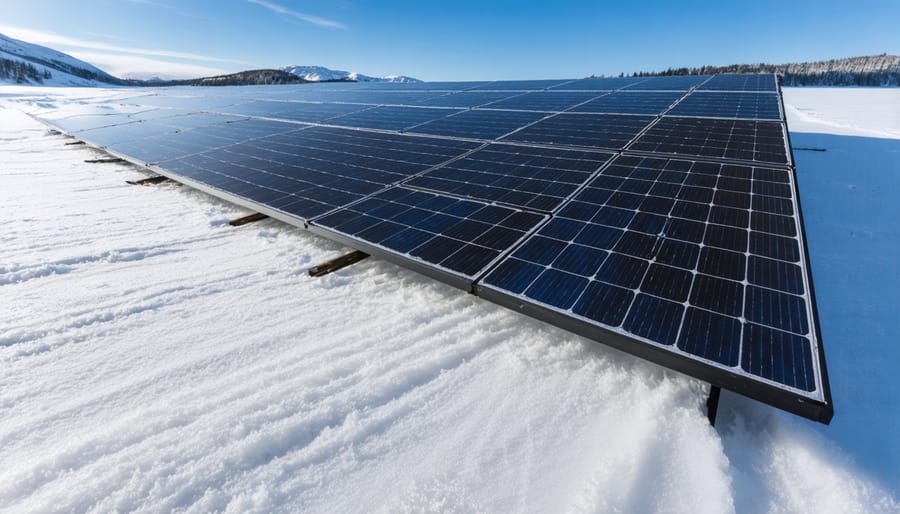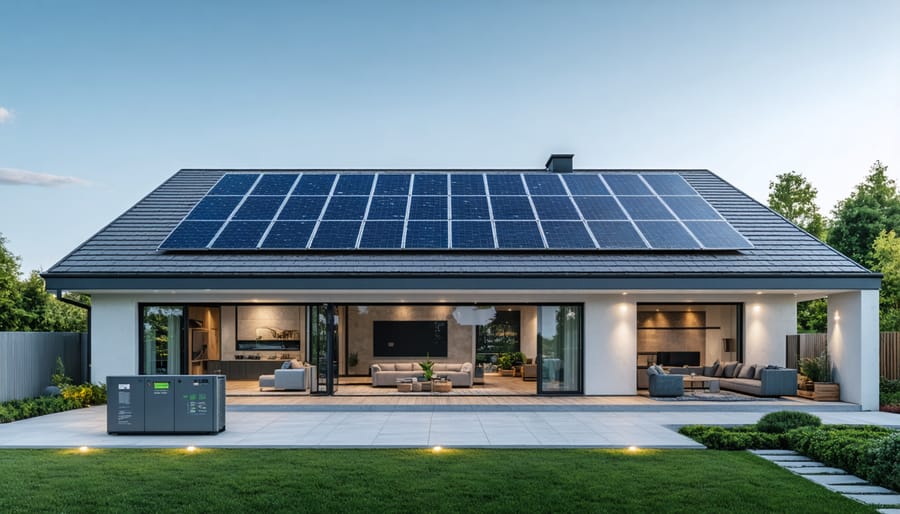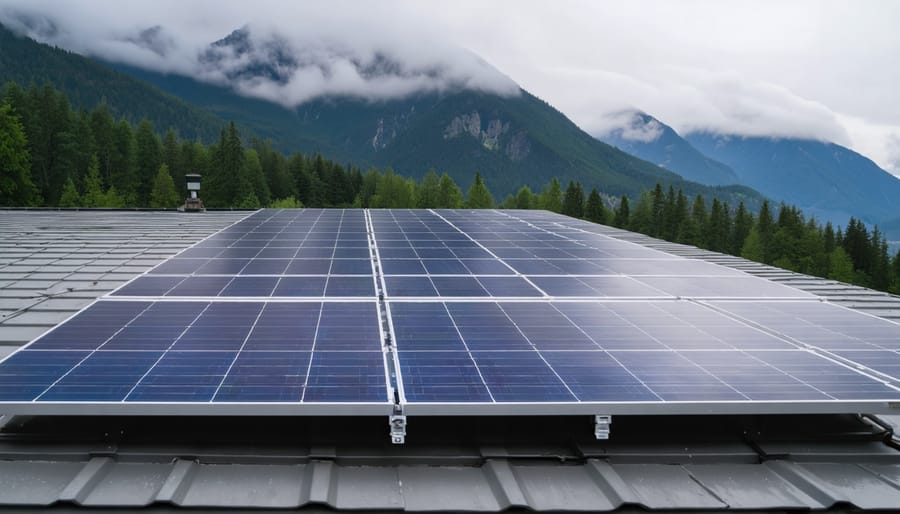Calculate your home’s total daily power consumption in kilowatt-hours (kWh) before sizing your off-grid solar system in British Columbia. Most BC homes require between 20-40 solar panels to operate fully off-grid, based on average daily usage of 30 kWh and typical solar conditions in the Pacific Northwest.
Factor in BC’s unique seasonal variations – winter months receive 75% less sunlight than summer, demanding larger systems with 30-50% more panels than grid-tied alternatives. A 2,000-square-foot home in Vancouver typically needs a 10kW system with 28-32 high-efficiency panels to maintain energy independence year-round.
Consider critical factors beyond panel count: battery storage capacity for 3-5 days of autonomy, inverter sizing at 20% above peak load, and mounting locations that maximize southern exposure while accounting for coastal weather patterns. Recent installations across BC’s Lower Mainland demonstrate that proper system sizing, combined with energy-efficient appliances and smart home management, can achieve complete energy independence even in our challenging climate.
Start by tracking your current electricity consumption over several months – this foundation determines your exact panel requirements and ensures your off-grid system meets your household’s unique energy needs.
Understanding Your Home’s Energy Needs
Calculating Daily Energy Usage
To accurately determine your solar panel needs, start by calculating your daily energy usage from your BC Hydro bills. While average household energy consumption in BC is around 22 kWh per day, your actual usage may differ significantly.
Gather your last 12 months of electricity bills to account for seasonal variations. Look for the “Total kWh Used” on each bill and follow these steps:
1. Add up the total kWh used for all 12 months
2. Divide the total by 365 days to get your daily average
3. Add 10% to account for system losses and future needs
For example, if your annual consumption is 8,000 kWh:
8,000 ÷ 365 = 21.9 kWh per day
21.9 + 10% = 24.1 kWh daily target
Keep in mind that winter usage often spikes due to heating and shorter daylight hours. Review your highest-consumption months carefully, as your solar system must meet these peak demands. Consider energy-efficient upgrades before sizing your system – reducing consumption can significantly decrease the number of panels needed.
For more precise calculations, BC Hydro’s online account portal provides detailed daily usage data, which can help identify consumption patterns and opportunities for energy savings.
Seasonal Variations in BC
British Columbia experiences significant seasonal variations that directly impact both solar energy production and household energy consumption. During summer months (June to August), BC residents enjoy long daylight hours, with some regions receiving up to 16 hours of sunlight daily. This period offers peak solar generation potential, often producing surplus energy that can be stored for later use.
However, winter presents unique challenges. From November to February, daylight hours decrease significantly, with some areas receiving only 8 hours of sunlight. Winter also brings increased cloud cover and occasional snow, which can reduce solar panel efficiency. Despite these challenges, modern solar technology remains effective even in overcast conditions, typically operating at 10-25% capacity on cloudy days.
Energy consumption patterns in BC homes also fluctuate seasonally. Winter months see increased electricity usage for heating and lighting, while summer consumption typically drops, except for occasional air conditioning use. This inverse relationship between peak production and peak demand means BC homeowners need to carefully size their systems to meet winter energy needs.
To address these seasonal variations, successful off-grid systems in BC typically incorporate:
– Larger solar arrays to compensate for winter production decrease
– Robust battery storage systems
– Backup power solutions for extended periods of low solar production
– Strategic energy conservation measures during winter months
Monitoring your household’s seasonal energy patterns for a full year before sizing your system will help ensure adequate year-round power supply.

Solar Panel Requirements for BC Homes
Panel Efficiency in BC’s Climate
British Columbia’s unique climate presents both opportunities and challenges for solar power generation. While the province experiences significant seasonal variations in daylight hours, modern solar panels have proven remarkably effective even in our coastal environment. Understanding solar panel performance in cloudy conditions is crucial for BC homeowners considering off-grid systems.
Contrary to common belief, solar panels can generate substantial power even during our overcast winter months. The Vancouver Island and Lower Mainland regions receive approximately 2,000 hours of sunshine annually, with peak efficiency during our long summer days. Modern panels typically operate at 15-20% efficiency, though this can vary based on location and seasonal conditions.
Coastal areas like Victoria and Vancouver experience about 70% of optimal solar conditions compared to sunnier regions, yet still provide sufficient energy for off-grid homes when properly sized. Interior regions such as Kelowna and Kamloops benefit from up to 2,200 hours of annual sunshine, offering even better generation potential.
Real-world data from BC installations shows that a well-designed system can meet household needs year-round, particularly when combined with adequate battery storage. Many local homeowners report exceeding their expected energy production during summer months, which helps offset reduced winter generation.
To maximize efficiency in BC’s climate, consider factors such as panel orientation, tilt angle, and snow-shedding capabilities. South-facing installations with a 30-45 degree tilt typically yield optimal results in our latitude.

Space Requirements and Mounting Options
A typical residential solar installation requires approximately 300-400 square feet of unobstructed roof space for every 5 kW of system capacity. For an average BC home aiming to go completely off-grid, you’ll need about 600-800 square feet of available space to accommodate a 10-12 kW system.
When evaluating your roof, consider its orientation and pitch. South-facing roofs with a 30-45 degree angle are ideal for maximum solar exposure in British Columbia. However, east and west-facing surfaces can still be viable options, though they may require additional panels to compensate for reduced efficiency.
If your roof isn’t suitable due to space limitations, shade, or structural concerns, ground-mounted solar solutions offer an excellent alternative. These installations can be optimally positioned for maximum sun exposure and are easier to maintain, though they require sufficient yard space and proper zoning clearance.
For homes with limited ground space, creative mounting options include carport installations, pergolas, or even vertical wall mounting on south-facing walls. Many BC homeowners successfully combine multiple mounting locations to achieve their desired system capacity while maintaining their property’s aesthetic appeal.
Remember to factor in setback requirements from property lines and maintain adequate spacing between panels for maintenance access. Working with a local solar installer will help determine the most efficient layout for your specific situation.

Battery Storage Calculations
To ensure reliable off-grid power, calculating your battery storage needs is crucial for those long winter nights and cloudy days in British Columbia. Start by determining your daily energy usage in kilowatt-hours (kWh) and multiply it by the number of days you want to maintain power without solar input (usually 2-3 days for BC’s climate).
For example, if your daily usage is 30 kWh and you want three days of autonomy, you’ll need 90 kWh of total storage capacity. However, to protect battery life, you shouldn’t discharge them completely. Most battery storage options in BC recommend using only 50% of total capacity, so you’d actually need 180 kWh of storage.
Consider seasonal variations too. During BC’s darker winter months, you might need additional capacity. A good rule of thumb is to add 20% to your calculated storage needs for winter operation. Using our example, this brings the total to 216 kWh.
Don’t forget to factor in temperature effects. Most batteries perform best between 20-25°C, and capacity can decrease by up to 40% in cold weather. Installing batteries in a temperature-controlled space can help maintain optimal performance year-round. Working with local installers who understand BC’s climate challenges will ensure your battery bank is properly sized for reliable off-grid living.
Real-World Examples from BC Homeowners
Coastal Region Installation
On Vancouver Island, where coastal conditions bring unique challenges and opportunities for solar installations, homeowners typically need a larger system compared to inland locations. Take Sarah’s home in Nanaimo, for example – a 2,000-square-foot house that successfully runs off-grid using a 10kW solar system with 28 panels.
The island’s maritime climate means fewer sunny days, but longer daylight hours in summer can offset this limitation. A typical Vancouver Island home consuming 30 kWh daily requires approximately 24-32 panels to maintain energy independence throughout the year, accounting for the region’s average of 2,000 hours of annual sunshine.
Local installers recommend adding 20-25% more panels than mainland calculations suggest, specifically to handle the extended periods of overcast weather from November through February. This means if standard calculations suggest 20 panels, coastal homeowners should consider installing 24-25 panels for reliable year-round performance.
To maximize efficiency in coastal conditions, panels are typically installed at a steeper angle (35-40 degrees) to optimize winter sun exposure and help rain wash away salt spray and debris. Many island residents pair their systems with hybrid inverters and lithium batteries, storing excess summer production for use during darker winter months.
Remember, these figures represent averages – your specific needs may vary based on location, energy consumption, and property characteristics.
Interior BC Setup
Meet Sarah and Tom, who built their off-grid solar system in the Okanagan Valley near Vernon. Their 2,000-square-foot home runs entirely on solar power, demonstrating what’s possible in Interior BC’s sunny climate.
Their system consists of 24 solar panels, each rated at 400 watts, for a total capacity of 9.6 kW. The array was sized specifically for the region’s climate, taking advantage of the Okanagan’s 2,000+ hours of annual sunshine. The system generates enough power to run their energy-efficient appliances, heating, and cooling throughout the year.
The couple installed their panels at a 30-degree angle facing due south, optimizing winter production when the sun is lower in the sky. To account for shorter winter days and occasional cloudy periods, they included a 48V lithium battery bank with 30 kWh of storage capacity.
Their setup cost approximately $35,000 after rebates and incentives, with an expected payback period of 12-15 years. The system produces surplus energy during summer months, which they use to charge their electric vehicle and power their garden irrigation system.
Key to their success was careful planning of their energy needs, selecting energy-efficient appliances, and implementing a robust monitoring system to track their power generation and consumption patterns. Their experience shows that with proper sizing and planning, off-grid living in Interior BC is not just possible, but practical and sustainable.
System Optimization and Maintenance
Seasonal Adjustment Strategies
In British Columbia’s varied climate, adjusting your solar panel system throughout the year is crucial for optimal performance. During summer months when daylight is abundant, focus on regular cleaning to remove pollen and dust, ensuring maximum sunlight absorption. Consider installing adjustable mounting systems that allow you to modify panel angles – aim for a 30-degree tilt in summer and increase to 45 degrees in winter to maximize exposure.
Snow management becomes essential during winter months. While some snow naturally slides off tilted panels, keep a long-handled brush handy for gentle removal when accumulation exceeds 5cm. Remember that snow reflection can actually increase panel efficiency on clear winter days.
Install a monitoring system to track seasonal performance variations and adjust energy usage accordingly. During shorter winter days, implement energy-saving practices like using major appliances during peak sunlight hours and reducing non-essential power consumption after dark.
Consider adding a wind turbine to your system for winter months when solar generation typically decreases. Many BC homeowners find this hybrid approach particularly effective in maintaining consistent power supply throughout the year.
Essential Maintenance Schedule
Regular maintenance is crucial for keeping your off-grid solar system running efficiently in BC’s diverse climate conditions. Schedule quarterly inspections of your panels, paying special attention to debris accumulation from surrounding trees and checking for any physical damage. During fall, clear fallen leaves to maintain optimal performance, and implement proper winter maintenance for solar panels to prevent snow buildup.
Clean your panels at least three times per year using soft water and a non-abrasive cloth. In coastal areas, you’ll want to clean more frequently due to salt spray. Monitor your battery bank monthly, checking fluid levels in flooded lead-acid batteries and ensuring proper ventilation in your battery storage area.
Inspect wiring connections annually for signs of wear or corrosion, particularly before winter sets in. Have a certified technician perform a comprehensive system check-up annually, including inverter efficiency testing and charge controller calibration. Keep detailed maintenance logs to track system performance and identify potential issues early.
Embarking on your off-grid solar journey in British Columbia is an achievable goal with proper planning and understanding. As we’ve explored, determining the right number of solar panels depends on several key factors: your household’s energy consumption, available roof space, local climate conditions, and battery storage needs.
Remember to start by calculating your daily energy usage and accounting for seasonal variations in BC’s climate. A typical home in our region might require between 20-30 panels for complete off-grid living, though your specific needs may vary. Consider working with local solar installers who understand BC’s unique environmental conditions and can provide tailored solutions.
Before making your final decision, we recommend taking these practical next steps:
– Conduct a detailed energy audit of your home
– Get multiple quotes from certified solar installers
– Review local building codes and permit requirements
– Explore available renewable energy incentives
– Consider starting with a grid-tied system before transitioning to full off-grid
Many BC homeowners have successfully made the switch to off-grid living, proving it’s a viable option for sustainable energy independence. With proper planning, professional guidance, and realistic expectations, you can join our growing community of solar-powered homes while contributing to BC’s clean energy future.
Remember, going off-grid is a journey, not a race. Take time to research, plan, and implement your system thoughtfully for the best long-term results.

